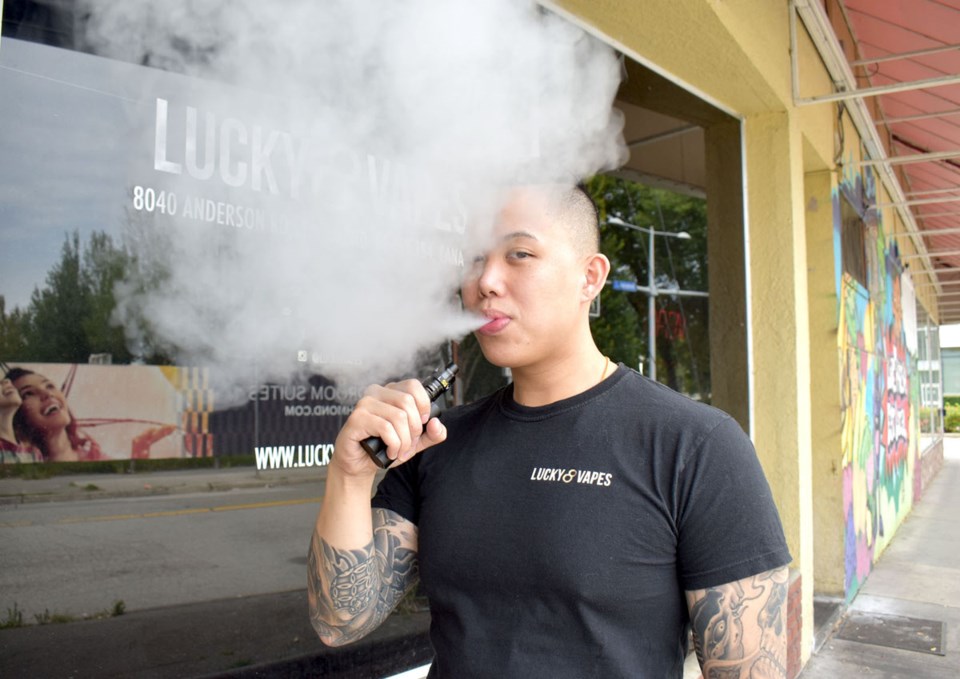On the surface, vaping is being marketed as a safer alternative to smoking — which it is. But the fact many of the e-juice flavours were initially candy tasting had some accusing producers of a more sinister motive: to hook young people.
The government has since cracked down on packaging so as not to be as inticing for youth, but the numbers are still alarming, according to Meena Dawar, a Vancouver Coastal Health (VCH) public health officer.
“Youth who try e-cigarettes are more likely to try tobacco products. And what (one) study showed, which is shocking, is that after 30 years of declining youth smoking rates in Canada, youth smoking rates are on the increase in Canada,” Dawar said.
She warns that, while e-cigarettes might be a harm-reduction tool for smokers, the health authority is seeing a rise in youth vaping as well as an increase in youth smoking regular cigarettes. VCH is worried these statistics are linked.
Both increases were found in a recent study by David Hammond who looked at youth vaping and smoking in Canada, the U.S. and England. According to Hammond’s study, past 30-day smoking was up from around 10 per cent in 2017 to 15.5 per cent in 2018.
Statistics for past 30-day vaping were up in the same time period from 8.4 per cent to 14.6 per cent.
However, in comparison to smoking cigarettes, Dawar does concede, vaping is better.
Richmond business owner Pasu Wong was smoking up to a pack a day by the age of 22, a habit he started in high school. When he decided one Sunday after leaving church that it was time to quit smoking, it took him an hour and a half to find a vape store. That’s when he and his friend Bryan Villabroza decided to start their own vape business.
Six years later, the pair own Lucky 8 Vapes on Anderson Road and another location by the same name in Vancouver.
Their store has tinted glass — to avoid any inadvertent advertising of their products — and a strict over-19 policy.
“We do our due diligence and check two pieces (of identification),” he said.
The rules around vape stores are very strict, Wong points out, but he finds these rules at odds with other “grey area” markets, like cannabis dispensaries — of which there were dozens in Vancouver before legalization — and even liquor stores whose products are made to appeal to their customers.
Health Canada inspectors remind Wong and his associates regularly about the rules but they often seem inconsistent, for example, he can have the name “Lucky 8 Vapes” on his storefront, but he was told he couldn’t have the phone number 447-VAPE on the awning.
Wong also finds it unfair that his store is so strictly regulated while vaping products can be advertised publicly. Vype, a product made by Imperial Tobacco Canada, advertises at a Vancouver SkyTrain station, something allowed by the federal government and which TransLink can’t reject under the freedom of expression laws in the Canadian Charter of Rights and Freedoms, according to TransLink spokesperson Jill Drew.
It is up to the federal government to change the advertising rules of vaping products.
Regarding rules around the names of e-juices so that they aren’t designed to appeal to youth, that’s something Wong said he agrees with.
Under-age vaping and using e-cigarettes to quit smoking are two very different things, notes Dawar.
While e-cigarettes seem to be less harmful for people who smoke, they aren’t recommended for youth and non-smoking adults, Dawar said. There have been heavy metals and carcinogens found in some e-juice flavours, Dawar said, but in much lower concentrations than regular cigarettes.
Dawar said she thinks the number of youth vaping is higher than what studies have shown based on the “huge increase” in requests from schools in the last year for education for their students.
Vaping among youth is blatant, with schools reporting youth using e-cigarettes openly on school grounds and both inside and outside the classroom, Dawar said, adding that even during information sessions about vaping, public health officers have noticed vaping in class.
Vapes look like pens or USB sticks, Dawar pointed out, and the newer ones produce less vapour, so it’s easy to use without someone noticing.
There are even hoodies where the devices can be inserted discreetly into the hood for easy access, Dawar explained.
“It speaks to, A, the industry, and, B, youth culture and someone capitalizing on the interest by coming out with this clothing,” Dawar said.
Wong has heard many positive stories about people quitting smoking by vaping. And if people come in and ask for nicotine-infused juices and they currently don’t use nicotine, he will discourage them from buying it.



